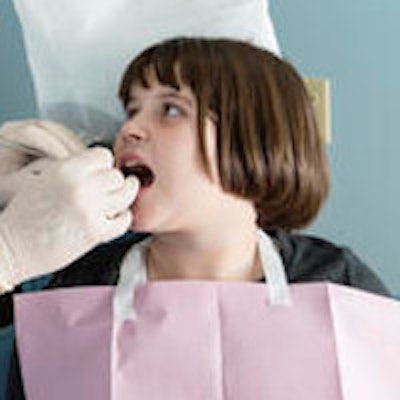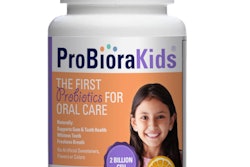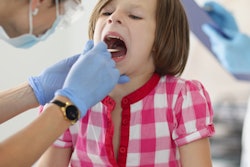
Over the last 10 years that I have been treating halitosis, most of my patients were adults, but surprisingly, two of my most recent patients were children. Periodontal disease is known to be a cause of breath odor in adults, but a common assumption is that children are too young to have periodontal disease, so, therefore, they shouldn't have chronic breath odor. This is a false assumption, according to a 1999 study in the Journal of Pediatrics (March 1999, Vol. 134:3, pp. 338-343) and a 2003 study in Pediatric Dentistry (November-December 2003, Vol. 25:6, pp. 553-558).
 Jim Hyland, DDS.
Jim Hyland, DDS.In fact, a 2014 study published in International Journal of Dental Hygiene (August 2014, Vol. 12:3, pp. 208-212) found that halitosis was present in about 40% of the children participating in the study.
Although their mouths may appear to be healthy, many children are afflicted with periodontal disease, which is commonly transmitted by their parents, usually by kissing and sharing food and eating utensils, according to a 2006 study in the Journal of Dental Research (February 2006, Vol. 85:2, pp. 182-186).
The bacteria that cause periodontal disease in adults also behave the same way in a child's mouth -- they absorb proteins and metabolize them, producing hydrogen sulfide, methyl mercaptan, and dimethyl sulfide. These volatile sulphur compounds are expelled with the air we breathe out and are responsible for those offensive breath odors.
Often in these cases, bacteria residing as complex biofilms on the surface of the tongue and in the gingival crevices exist without an inflammatory response, but they produce these odors as they metabolize amino acids such as cysteine and methionine. This is why a child can have offensive breath odor despite having healthy-looking oral tissue.
Since these periodontal pathogens are found thriving within the oral biofilm throughout the entire mouth, you need to effectively treat the entire oral biofilm to halt periodontal disease and, in turn, chronic breath odor.
Pediatric halitosis case report
A 7-year-old girl came to my office with the chief complaint of bad breath. She was being teased by children at school because of the foul odor from her mouth. To avoid teasing from her classmates, she avoided social interaction and did not go out during recess. This was very stressful for her and her family.
Ironically, her grandfather was a dentist who saw her every three months for a hygiene visit. Despite a thorough daily home-care regimen and the use of over-the-counter rinses, she continued to have severe breath odor. Her grandfather was aware that I had successfully treated similar cases of pediatric halitosis, so she was referred to our practice.
We did a complete oral examination and measured the extent of the breath odor by taking a breath sample using a portable gas chromatograph called Oral Chroma. This device measured the pretreatment levels of hydrogen sulfide, methyl mercaptan, and dimethyl sulfide with baseline levels of these volatile sulfide compounds established as 112/26/12. Measurements greater than 112/26/12 collectively or separately will indicate the level and type of odor that is detected on the breath of the patient, according to a 2011 study in Medical Principles and Practice (December 2010, Vol. 20:1, pp. 75-79).
Sally's readings were 125/0/0, which are just above the threshold for noticeable breath odor from hydrogen sulfide. To further determine the intensity and location of the odor, we used an organoleptic measurement scale of 0 to 5, with 5 being the strongest odor.
Using a mirror, we placed it at the tongue base, removed it quickly and dried the mirror with the air syringe. We determined the odor to be a 4 for the tongue base. The tongue dorsum was a 3. When we smelled the floss from between the teeth, it ranged from a 2 to a 4. The odors were coming from everywhere.
Salivary pH was checked, and the tongue dorsum was basic at 8.2. Basic pH is most often associated with the presence of periodontal pathogens, whereas as pH of 5.5 or lower is associated with caries. The patient had ample saliva for clearance. We used a two-tone disclosing solution on all tooth surfaces, and this revealed a thick layer of gingival biofilm around the posterior teeth even though her mother helped her with home care.
Tonsils
The patient was well-hydrated and had a normal diet free from spicy foods. Her health history was normal, and she was taking no medications. The patient had swollen tonsils on examination with multiple crypts containing tonsilloliths/tonsil stones. These are curd-like masses that contain dead cells, food debris, and many periodontal pathogens.
Intraoral muscles squeeze these tonsilloliths out onto the tongue at inappropriate times and produce strong, foul odors. Surgeons will seldom perform an invasive tonsillectomy to remedy odor issues, so the patient had few options.
Three site-specific samples of biofilm were taken from the tongue base and dorsum, as well as between the teeth. This biofilm was placed on a microbiology slide and was sent to a lab for a gram-negative stain analysis. This differs from a DNA test, which samples saliva or subgingival bacteria and provides information on the species of certain bacteria present in the oral cavity.
Gram-stain analysis, on the other hand, is site-specific for information from three or six sites. You need to determine where the odors or infection is located to provide effective breath care. A copy of the lab report is included in this case report for each of her three visits: pretreatment, post-treatment, and follow-up evaluation. The reports show counts of both gram-positive and gram-negative bacteria, yeast, amoebae, and numbers of white blood cells. White blood cells (neutrophils) appear in high numbers when infection is present. This report is useful in determining the extent of infection that is present and in selecting the appropriate treatment.
Treatment
The first report (figure 1) showed substantial amounts of gram-negative bacteria that were above threshold levels. We prescribed a pediatric dose of metronidazole/nystatin compounded suspension (Oravital) with instructions to rinse three times a day for two weeks.
%{[ data-embed-type="image" data-embed-id="641f35f7da01648223832d46" data-embed-element="span" data-embed-alt="Figure 1: The patient's microbiology results for the first appointment and second appointment for evaluation of treatment. Green means within normal limits, orange means the level should be monitored, and red indicates an infection. *Maxillary teeth samples **Mandibular teeth samples ***White blood cells or polymorphonuclear leukocytes (inflammatory response) All images courtesy of Dr. Jim Hyland." data-embed-src="https://img.drbicuspid.com/files/base/smg/all/image/2016/03/drb.2016_03_18_15_32_57_863_2016_03_21_ped_halitosis1_550.png?auto=format%2Ccompress&fit=max&w=1280&q=70" data-embed-caption="Figure 1: The patient's microbiology results for the first appointment and second appointment for evaluation of treatment. Green means within normal limits, orange means the level should be monitored, and red indicates an infection.<br>*Maxillary teeth samples **Mandibular teeth samples ***White blood cells or polymorphonuclear leukocytes (inflammatory response) All images courtesy of Dr. Jim Hyland." data-embed-width="550" data-embed-height="290" ]}%Even at low concentrations of antibiotic, these rinses can penetrate oral biofilms at the base of the tongue and tonsils. The antibiotic particles that are suspended in the rinse can stick to oral biofilms and also penetrate into the sulcus to control the pathogenic bacteria.
After completing the antibiotic rinse regimen, the patient continued her treatment by rinsing twice daily for another two weeks with a 0.2% nonstaining chlorhexidine. Use of the chlorhexidine helps to rebalance oral biofilms by reducing the gram-positive streptococci.
Home care
Although over-the-counter mouthwashes can control mild halitosis, they are insufficient for eliminating moderate to strong and chronic breath odors. However, these rinses can be helpful in maintaining a biofilm balance once the antibiotic rinse treatment regimen has been administered and completed.
We also selected a sodium chlorite maintenance rinse for the patient to use twice a day. In addition, prescribing an oral probiotic to repopulate commensal bacteria in the oral cavity has been helpful in many bad breath cases, and we decided to try this as part of the patient's treatment.
To help her maintain good oral hygiene, we demonstrated a circular, gum-focused, tooth brushing technique. The patient was also given a tongue scraper to use daily. Because the floss that we typically recommend for adults will not fit in between the teeth of most 7-year-olds, we demonstrated flossing with double thickness so the floss would engage both the tissue and the tooth surface. She was reminded to drink more water and avoid protein snacks before bedtime.
Follow-up
When we re-examined the patient in four weeks, my nose detected no odors, but the Oral Chroma readings, at 64/0/0, indicated that there was some hydrogen-sulfide production. This was likely caused by the continued presence of tonsilloliths or tonsil stones. The microbiology report was vastly improved, but some pathogens remained, posing a risk for reinfection (see OV2 in figure 1 above). Her pH was within the normal range.
The patient's mother reported that she did not detect any odors and that the patient was comfortable in playing with her friends at school. Based on the slightly elevated Oral Chroma readings and the continued presence of pathogens producing volatile sulfide compounds, we mentioned to the mother that retreatment with a different antibiotic rinse would be needed if the odors returned.
Before reviewing brushing and flossing, a two-tone disclosing solution was applied to show the patient what areas required improvement. As the last step in this process, a maintenance rinse protocol was recommended. The patient was to rinse with over-the-counter SmartMouth (Triumph Pharmaceuticals) twice a day, five days a week to continue reduction of gram-negative bacteria and with chlorhexidine 0.2% twice a day for the remaining two days to balance the gram-positive component of the biofilm.
We checked her one more time two months later, and, although there was a slight increase in gram-negative bacilli (figure 2), no odors were present.
 Figure 2: Patient's microbiology results six weeks post-treatment. For the three-site results, samples from maxillary and mandibular teeth were combined for microscopic analysis.
Figure 2: Patient's microbiology results six weeks post-treatment. For the three-site results, samples from maxillary and mandibular teeth were combined for microscopic analysis.When the patient came for her recare appointment after being stable for a year and eight months, the odors and tonsilloliths had returned. Her microbiology report (figure 3) confirmed the increased presence of oral pathogens, although the levels were less than in the original report. This time she was prescribed a tetracycline/nystatin rinse to use for a period of two weeks.
 Figure 3: Samples taken one year and eight months post-treatment. Oral pathogens have increased to pretreatment levels. Patient was retreated with the antibiotic rinse.
Figure 3: Samples taken one year and eight months post-treatment. Oral pathogens have increased to pretreatment levels. Patient was retreated with the antibiotic rinse.We evaluated her progress after the second antibiotic rinse. She had normal breath, and her Oral Chroma readings were 8/0/0. For her maintenance rinse, she was to use a sodium chlorite rinse for five days and to continue rinsing with chlorhexidine twice a week. After this regimen, she has continued to be stable.
Conclusion
Breath odor is a complex interaction of periodontal pathogens and host response. Gingival tissues and tongue papillae can have the appearance of being healthy, but they can have substantial mouth odor. When children have bad breath, it can be difficult to diagnose, especially when the tissues appear healthy. What's more, this condition causes significant stress and embarrassment for the child, so we must be sensitive to these patients' emotional needs.
Microbiological testing is necessary to determine the location and presence of bacteria capable of odor production, and sampling should be from the throat, tongue, and the subgingival biofilm. An antibiotic rinse is effective in reducing these pathogenic bacteria. This method provides direct contact with pathogens in sufficient quantities to balance the oral biofilm.
When brushing and flossing, regular dental cleaning, and using over-the-counter rinses do not control breath odor, consider this more than a casual occurrence and treat it as a serious condition. In addition to the presence of invasive periodontal pathogens, volatile sulfide compounds produced by these bacteria are harmful, toxic gases that alter both taste and smell abilities of the patient.
Lastly, the social and psychological harm suffered by the young patient may have permanent effects. It is important that this be recognized and that the appropriate diagnostic techniques are applied to determine the cause and provide treatment as soon as the problem is identified.
Jim Hyland, DDS, is the president and CEO of Oravital. He can be reached at [email protected].
The comments and observations expressed herein do not necessarily reflect the opinions of DrBicuspid.com, nor should they be construed as an endorsement or admonishment of any particular idea, vendor, or organization.



















